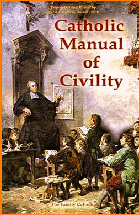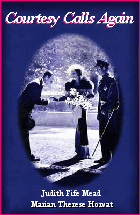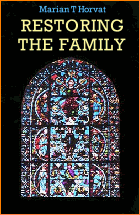Book reviews
 |
 |
 |
 |
 |
 |
 |
Fr. Magín Catalá:
The Wonder-Worker of California
Review of The Holy Man of Santa Clara or Life, Virtue, and Miracles of Fr. Magín Catalá, by Zephyrin Englehardt, O.F.M. San Francisco, 1909, 228 pp.
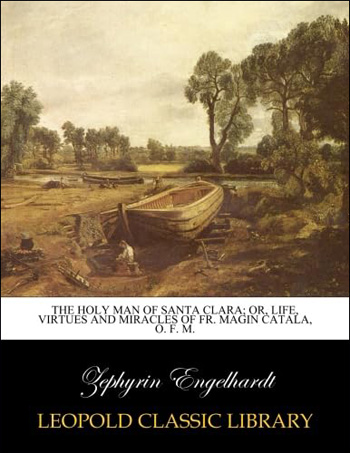
Purchase here
The Church herself has acknowledged his holiness. In 1884, the Archbishop of San Francisco instructed the canonical process of beatification of Catalá, In 1908, the Congregation of the Causes of Saints instituted the beatification process, but it has languished ever since, despite a wealth of documented testimonials of miracles worked, prophecies fulfilled, and bilocations witnessed by this Franciscan monk, which always had the testimony of more than one individual.
The Franciscan author, Fr. Zephyrin Englehardt, known as “The Father of Mission History,” was named Vice-Postulator for the cause of Fr. Magín, and in 1909 he published this work, meticulously documenting every fact and miracle. After finishing the last page, the reader is certain that Fr. Magín was a holy man and wonder-worker.
His life
Fr. Magín Catalá was born in January of 1761 in Spain. Practically nothing is known of his childhood except for Baptism and Confirmation records. He entered a Franciscan monastery at age 16 and was elevated to the priesthood around 1785, then sailed for the New World in 1786. He spent some time in Mexico City and Nootka Sound before finally reaching the longed-for destination of California.
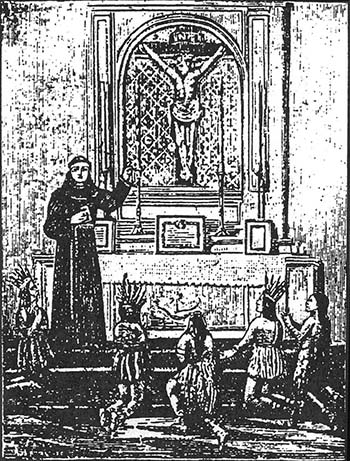
No photo exists of Fr. Magín, who wanted to be hidden & unknown. Above, a sketch of him teaching the Indians in his customary place
Fr. Magín added many additional fasts and sacrifices to the obligatory requirements, and very soon contracted chronic inflammatory rheumatism, which afflicted him for the rest of his life. Given his constantly declining health, he could have been relieved of his position to retire at the mother college in Mexico City. Twice he requested this and was granted permission, but then opted to remain at his post. He could not leave the Indians who loved and respected him so much.
During his last four years, he could no longer walk or stand unaided, and was thus unable to administer Baptism or assist at funerals. Notwithstanding the physical pain, he would sit before the Communion rail in the Sanctuary to preach and teach the Indians who gathered around him.
The practice of virtue
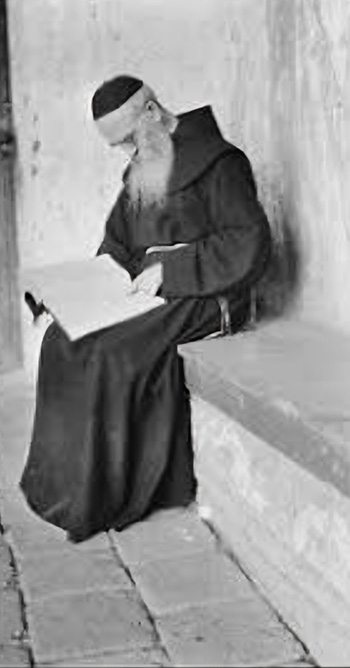
Fr. Zephyrin Englehardt, ‘The Father of Mission History’ & vice-postulator for Fr. Magín's cause
Like the Curé of Ars, he preached strongly against gambling, immodest dancing, and extravagance in dress. (p. 70). The Holy Man of Santa Clara would have been shocked at some of the Masses of our late Pontiffs where Aztec costumes and indigenous attire have been welcomed. When the natives of his time appeared at the church in feathers, ribbons and other gaudy decorations on their heads, Fr. Magín,would not allow them to enter the sacred edifice until they had removed all such ornaments. (p. 81)
He followed the vow of poverty in an exemplary way, sleeping on the bare floor, or at most upon a hide or blanket, without undressing. An adobe brick served for a pillow. (p. 130) Since the fathers regarded themselves merely as stewards of the Mission goods and finances, safeguarding them for the use and eventual ownership of the Indians, even his stipend, gifts and personal donations went into the common fund for the Indians. The calumnies being spread today are vicious attempts to malign their goodness. (p. 131)
Another Black Legend pretends the female neophytes in the care of the missions were locked up against their wills and were unable to move about freely. In fact the adolescent girls and single women without a home willingly lived in a house apart from the Indian village in order to preserve their chastity. In the daytime they were at liberty, when not occupied, to visit their parents in the adjoining village (pp 102-103).
Miracles & prophecies
Fr. Magín performed many miracles during his lifetime. One time innumerable locust, or chapulas, descended and devoured everything green in Santa Clara Valley. Fr. Magín directed the afflicted people to enter the Church with some caught locusts. After he said some prayers, he ordered the little creatures released. As soon as they were set at liberty, all the locusts rose in a body and plunged into the sea.
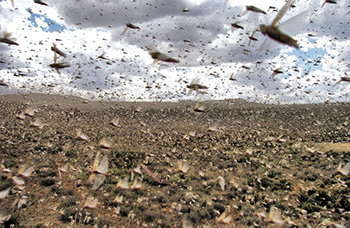
The swarm of locusts left en masse
after Fr. Magin's prayer
When women in labor were in desperate cases, they would send pleas for help to Fr. Magin. He would send a straw hat or girdle he sometimes wore; it would be applied and the result was always happy. (p. 110)
Many times his prophecies would occur during a sermon: He would abruptly interrupt it asking,“Let us recite an Our Father and a Hail Mary” for a person soon to meet a violent death, or unexpected accident, etc. The people came to quiver when they heard those words for the event would always follow as predicted.
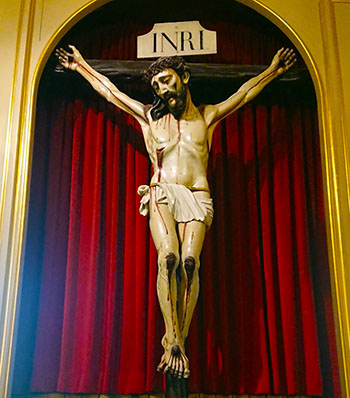
Fr. Magín was often seen levitating before this crucifix at a side altar in Mission Santa Clara's Church
At the end of his life when he could only preach while seated in a chair before the Sanctuary railing due to his health, he prophesied the apostasy that would occur in California, warning insistently of this. He said:
“People from almost all the nations of the earth will come to this coast. Another flag will come from the East and the people that follow it will have a different language and religion. These people will take possession of the country and lands. On account of their sins, the Californians will lose their lands and become poor, and many of their children’s children will give up their own religion.
“The Indians will be dispersed and not know what to do and they will be like sheep running wild. Heretics will erect church building, to replace be true temples of God.”(pp 123-124) How the Holy Man of Santa Clara would recoil to see the Prelates of our day who sanction the separation of Church and State and teach that all religions are equal in God’s eyes.
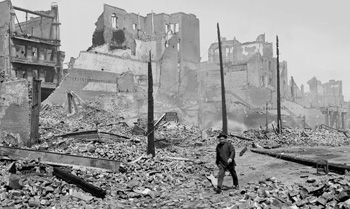
80% of San Francisco was destroyed in the 1906 earthquake, predicted by Fr. Magín
Fr. Magín was an exorcist and knew how to discern the presence of the evil one. Once, Fr. Zephyrin recounts that “the Indians of a certain rancheria were practicing witchcraft. All at once Father appeared among the wicked men, who astounded at his presence scattered in every direction. Yet it was shown that he had not left the mission at all.” (p. 177) This is but one of many instances of the reports of his being in two places at one time, the gift of bilocation which he had .
Grief & miracles after his death
Revisionists of California Mission history paint the Franciscan priests as oppressors, practitioners of genocide, and cruel beyond belief. If that were true, why at the death of Fr. Magín (on November 29, 1830, as he had predicted) did immense crowds of people flock to the Mission, weeping and crying out ‘The saint has left us!'?
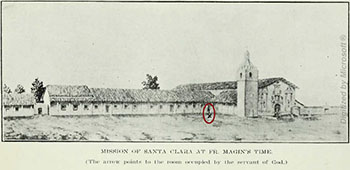
The room of Fr. Magín at Santa Clara Mission, below, the Indians at work under the direction of the Franciscans
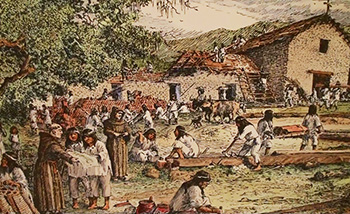
Many cures were reported after placing a relic of the saintly Padre on the ill person. One midwife of over 40 years testified that “when the outcome looked desperate, I would apply a relic of Fr. Magín. I have never lost a mother or child.” (p 186)
In particular he was invoked for the finding of lost articles or animals. He was truly the "St. Anthony" of the Indians, who would promise him a Rosary or a Mass said “in the honor of Fr. Magín” for granting the favor, which he generally did.
I would recommend this book to any person who has an interest in History, especially that of California and the Missions. I myself was greatly edified by this Holy Man of Santa Clara, and frequently seek his intercession on behalf of California.
Let us pray for the restoration of California for God’s glory, seeking the intercession of Our Lady of Bethlehem, Fr. Junípero Serra, and Fr. Magín Catalá!
Viva Cristo Rey!
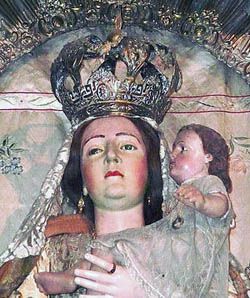
Our Lady of Bethlehem in Carmel Mission,
patroness of the California Missions
Posted October 13, 2025

______________________



